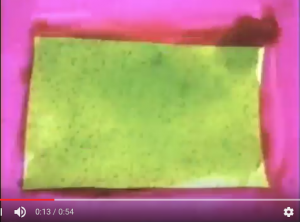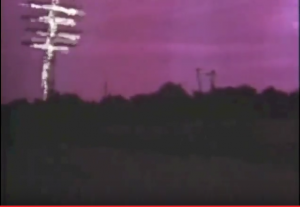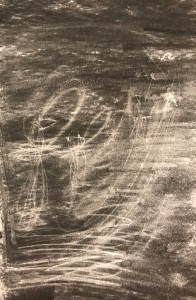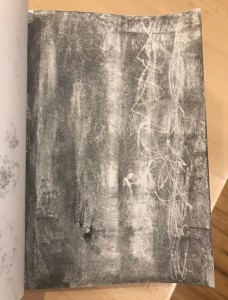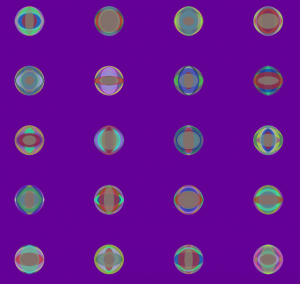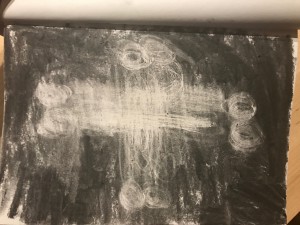For my conference conference I will be recreating frames and exerts from the experimental film ‘Scratch Pad’ (1960) by American photographer and experimental filmmaker/animator Hy Hirsh.
Here is currently the only available online footage from ‘Scratch Pad’ that I will be working from: https://youtu.be/sWj1K4i46ps
I’d be using techniques we studied in the course to create a greater sense of liveliness in his work and also blend my own style that has developed through using Processing . Here are six frames from a brief online exert of ‘Scratch Pad’ that I will recreate in Processing and use as a basis for my conference project:
I think this project would be an interesting way to demonstrate how the unconventional tools and techniques in early film/animation of 20th avant-gard artists for creating unpredictable abstract media would translate into modern computing that was created for the same purpose and could relatively achieve the same outcome.
My interest in experimental film and animation was what drew me to Hirsh as an artist because he was among the first filmmakers in the 20th century to incorporate electronic imagery into film. Hirsh experimented by using tools used in the film and animation industry of his time in an unconventional environment with other forms of media in order to create unexpected visual results. He would create randomly generated patterns in his films by using superimposed oscilloscope patterns printed through colour filters and ‘Scratch Pad’ utilises found-footage and graffiti with superimposed closeups of metallic structures to create the impression of 3D sculptures.
I think Scratch Pad, and Hirsch’s other works, could be considered as generative art because the patterns are created depending on how the material Hirsch uses effects the film which could make them autonomous because the process is unpredictable and out of the control of the artist. I think his work is also very relevant to what I’ve studied about “noise” because we’ve used noise in processing as a means to create natural imperfections and progression in our generative drawings and Hirsch’s goal for his films is to create expressive unpredictable shapes that change over the course of its duration to create a sense of liveliness for the viewer. I hope to achieve this same outcome for the viewer so that they can experience liveliness through unrestricted generated patterns.
However, my main concern for this project is that the final result may not contain the same kind of raw expression and results as Hirsch’s film because the patterns generated in Processing will be predictable to me as the artist whereas Hirsh’s circumstances were more accidental.However I think where I have the advantage is that processing can create the same effects that Hirsh strived for without having to use the same tools he had that aren’t at my disposal, such as an oscilloscope.
I tried to create similar scratch patterns from Hirsh in my sketchbook. For the first sketch I pressed onto the paper very hard with a dry pen so as to create imprints on the paper, or scratches, and then traced the surface with a pencil. This resulted in somewhat faint but textured white lines with a contrasting textured background:
For the other sketches I used a white colour pencil for making the imprints and then drew over the surface with charcoal. The white lined patterns were much more defined this time around and the fragility of the charcoal made it easier to the capture the imprints without having to push down too hard on the surface of the paper.
I incorporated some of the shapes and patterns from my own programs to Hirsh’s scratching style:
I really enjoyed this process because I felt there was a sense of control I had to give to the material since I could not see what I was actually drawing until I applied the charcoal but it felt more natural that way since generative art requires the artist to relinquish some control in order to give the art-piece autonomy.
As well as figuring out how I can incorporate my own programs to Hirsh’s ‘Scratch Pad’ style , I also looked towards the other students in the course and the artists they presented to the class for inspiration. I thought Moyna’s movie ‘beam’ created a very mesmerising effect on the viewer because of how the white lines around the the gyrating red beam move so fluidly whilst intertwined chaotically with ease. I also find it interesting how the lines in her movie are coming from different directions all at the same time to create unique pattern, which I think would be an interesting idea to apply to the horizontal and vertical chaotic line patterns in ‘Scratchpad’. 
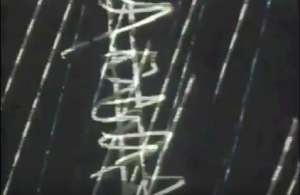
I also thought some aspects of Sonia Sheridan’s photography were very similar Hirsh’s approach to film in terms of how she tampers with the development process of the photograph in order to create new generated forms that transform the image.
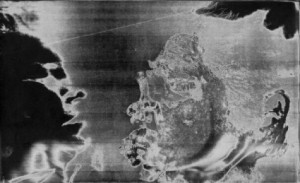
There is also how both artists use media to distort form such as how Sheridan superimposes her face onto the image with photocopier where as Hirsh mainly focuses on industrial landscapes and structures to create a less literal form. I may try to experiment with both these artists methods of distorting form in order to see how they may compare or contrast in practice.
I would first code my sketches by using “loops” as a means to create the shapes and patterns in ‘Scratch Pad’ with the same colour schemes as the frames in the film. However the shapes in the patterns all vary in form and none of them are symmetrical so I will be creating them through vertex shapes so as to give the impression that they are hand drawn and not generated by a computer. I would also use “for” to create some of the more finer details in the patterns such as the grainy dots that appear in the frame or random tears that resulted from Hirsh tampering with the actual film. For incorporating photography I would use the ‘image’ function to apply my own photographs into the program and see how the generated patterns could interact with the photograph.Once I have completed my still sketches my next step would be to animate them into a loop so as to capture the same vibrant movement in ‘Scratch Pad’ and apply more dimensions to them to create the same textures and spatial relationships of the patterns.
